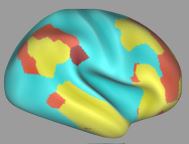Archived Content
The National Institute of Mental Health archives materials that are over 4 years old and no longer being updated. The content on this page is provided for historical reference purposes only and may not reflect current knowledge or information.
Our Brain’s Secrets to Success?
Unique support system promotes cortex growth, connectivity linked to prowess
• Press Release
Discoveries about how the human brain contributes to our success – both as a species and as individuals – are among the first fruit of projects funded under the National Institutes of Health BRAIN Initiative program as well as the Human Connectome Project . One study may help to explain the mystery of how our primate brain’s outer mantle, or cortex, was able to expand as much as 1000-fold through evolution, compared to other mammals. The other reveals that the more successful we tend to be – score higher on commonly considered positive personal qualities, such as education and income levels and life satisfaction – the more key parts of our brain tend to talk with each other when we’re not doing anything in particular.
A team of BRAIN Initiative-supported scientists, led by Arnold Kriegstein of University of California, San Francisco, reported in Cell, Sept. 24, 2015, on what may be the secret to the human cortex’s exponential growth. Another team led by Stephen Smith of University of Oxford, UK, and David Van Essen, Washington University, St. Louis, explains findings linking brain connectivity to measures of personal success Sept. 28, 2015 in the journal Nature Neuroscience. The studies were funded, in part, by the National Institute of Mental Health (NIMH) and other NIH components.
Kriegstein and colleagues found that the human cortex harbors a unique support system for neuron-producing factories during early brain development — in outlying cellular neighborhoods that barely exist in lower animals. The researchers discovered the molecular underpinnings of this unique group of stem cells that churn out thousands of neurons and support cells where their mouse counterparts produce only 10-100. They also discovered that the secret to this prolific output seems to lie in these cells’ ability to carry with them their own self-renewing “niches,” — support systems that enabled them to thrive in far flung circuit suburbs. The results add to a deeper understanding of the human brain’s parts list and enhance scientists’ ability to perform disease-in-a-dish experiments relevant to uniquely human disorders like autism and schizophrenia, which are difficult to model in rodents.
Smith’s group mined Human Connectome Project data on 461 individuals to find out whether any patterns of brain connectivity are associated with specific sets of correlated demographics and behavior. In addition to images of their resting state structural and functional brain connections, the Project collected data on 280 such subject measures, including psychological factors such as IQ, language performance, rule-breaking behavior and anger. A set of such measures statistically related to each other emerged as strongly correlated with connectivity between certain brain structures prone to talking with each other during the brain’s default mode, or resting state. This set was mostly composed of positive personal qualities, such as high performance on memory and thinking tasks, life satisfaction, years of education, and income. The set turned out to have a more than three-fold stronger correlation with increased brain connectivity than any of 99 other sets of measures examined. The brain regions associated with the set, which may be related to general intelligence, have been linked to higher-level human thinking – e.g., memory, imagination, sociability, value-guided decision-making and reasoning.
“It may be expected that these aspects of cognitive function would have an influence on life in a complex society,” note Smith and colleagues.
“It is great to see data from large investments like the Human Connectome Project and the BRAIN Initiative result in such interesting science so quickly,” said Greg Farber, Ph.D., director of NIMH’s Office of Technology Development and Coordination. “Both efforts seem very well positioned to continue to provide the research community with new tools and results to enhance our understanding of the brain.”

Smarts, life satisfaction, income and education levels – and other measures of success – were correlated with increased connectivity between certain areas of the brain while at rest. These parts of the brain (yellow, red, brown) talked with each other more while higher-scoring participants weren’t doing anything in particular. Picture shows composite data from functional magnetic resonance imaging scans.
Source: Stephen M. Smith, D.Phil., University of Oxford, David Van Essen, Ph.D., Washington University
Reference
Molecular Identity of Human Outer Radial Glia during Cortical Development. Pollen AA, Nowakowski TJ, Chen J, Retallack H, Sandoval-Espinosa C, Nicholas CR, Shuga J, Liu SJ, Oldham MC, Diaz A, Lim DA, Leyrat AA, West JA, Kriegstein AR. Cell. 2015 Sep 24;163(1):55-67. doi: 10.1016/j.cell.2015.09.004. PMID: 26406371
A positive-negative mode of population covariation links brain connectivity, demographics and behavior. Smith SM, Nichols TE, Vidaurre D, Winkler AM, Behrens TEJ, Glasser MF, Ugurbil K, Barch DM, Van Essen DC, Miller Kl. Nature Neuroscience, September 28, 2015.
Grants
U01-MH105989, U54MH091657, RO1-NS075998, RR09079/EB015894, F30-MH097312
BRAIN: Brain Research through Advancing Innovative Neurotechnologies
About the National Institute of Mental Health (NIMH): The mission of the NIMH is to transform the understanding and treatment of mental illnesses through basic and clinical research, paving the way for prevention, recovery and cure. For more information, visit the NIMH website.
About the National Institutes of Health (NIH): NIH, the nation's medical research agency, includes 27 Institutes and Centers and is a component of the U.S. Department of Health and Human Services. NIH is the primary federal agency conducting and supporting basic, clinical, and translational medical research, and is investigating the causes, treatments, and cures for both common and rare diseases. For more information about NIH and its programs, visit the NIH website .
NIH…Turning Discovery Into Health®
